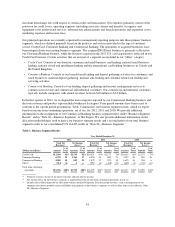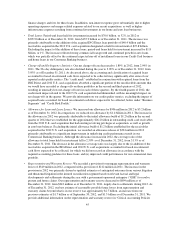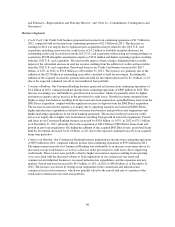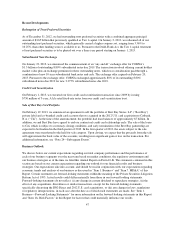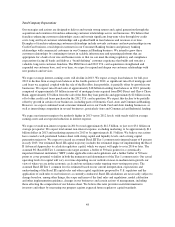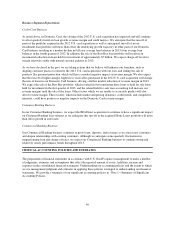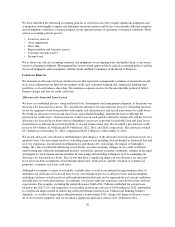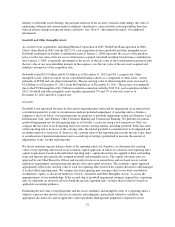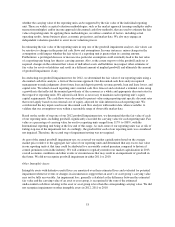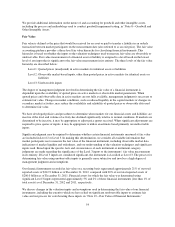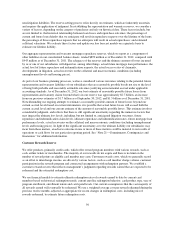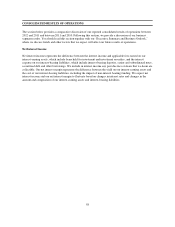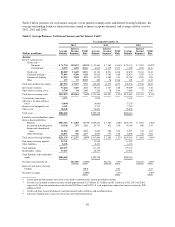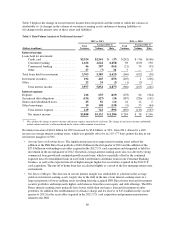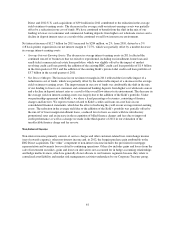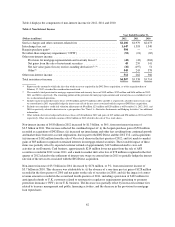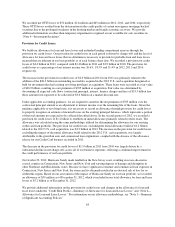Capital One 2012 Annual Report Download - page 72
Download and view the complete annual report
Please find page 72 of the 2012 Capital One annual report below. You can navigate through the pages in the report by either clicking on the pages listed below, or by using the keyword search tool below to find specific information within the annual report.whether the carrying value of the reporting unit can be supported by the fair value of the individual reporting
unit. There are widely accepted valuation methodologies, such as the market approach (earnings multiples and/or
transaction multiples) and/or income approach (discounted cash flow methods), that are used to estimate the fair
value of reporting units. In applying these methodologies, we utilize a number of factors, including actual
operating results, future business plans, economic projections, and market data. We also may engage an
independent valuation specialist to assist in our valuation process.
In estimating the fair value of the reporting units in step one of the goodwill impairment analyses, fair values can
be sensitive to changes in the projected cash flows and assumptions. In some instances, minor changes in the
assumptions could impact whether the fair value of a reporting unit is greater than its carrying amount.
Furthermore, a prolonged decrease or increase in a particular assumption could eventually lead to the fair value
of a reporting unit being less than its carrying amount. Also, to the extent step two of the goodwill analyses is
required, changes in the estimated fair values of individual assets and liabilities may impact other estimates of
fair value for assets or liabilities and result in a different amount of implied goodwill, and ultimately the amount
of goodwill impairment, if any.
In conducting our goodwill impairment test for 2012, we determined the fair value of our reporting units using a
discounted cash flow analysis, a form of the income approach. Our discounted cash flow analysis required
management to make judgments about future loan and deposit growth, revenue growth, loan and lease losses, and
capital rates. We relied on each reporting unit’s internal cash flow forecast and calculated a terminal value using
a growth rate that reflected the nominal growth rate of the economy as a whole and appropriate discount rates for
the respective reporting units. We adjusted cash flows as necessary to maintain each reporting unit’s equity
capital requirements. The cash flows were discounted to present value using reporting unit specific discount rates
that were largely based on our external cost of equity, adjusted for risks inherent in each reporting unit. We
corroborated the key inputs used in our discounted cash flow analysis with market data, where available, to
validate that our assumptions were within a reasonable range of observable market data.
Based on the results of step one of our 2012 goodwill impairment test, we determined that the fair value of each
of our reporting units, including goodwill, significantly exceeded the carrying value for each reporting unit. Fair
value as a percentage of carrying value for our five reporting units ranged from 117% to 188%, with the
International reporting unit being at the low end of this range. As such, none of our reporting units was at risk of
failing step one of the impairment test. Accordingly, the goodwill for each of our reporting units was considered
not impaired. Therefore, the second step of impairment testing was not required.
As part of the annual goodwill impairment test, we assessed our market capitalization based on the average
market price relative to the aggregate fair value of our reporting units and determined that any excess fair value
in our reporting units at that time could be attributed to a reasonable control premium compared to historical
control premiums seen in the industry. We will continue to regularly monitor our market capitalization in 2013,
overall economic conditions and other events or circumstances that may result in an impairment of goodwill in
the future. We did not recognize goodwill impairment in either 2011 or 2010.
Other Intangible Assets
Intangible assets with definitive useful lives are amortized over their estimated lives and evaluated for potential
impairment whenever events or changes in circumstances suggest that an asset’s or asset group’s carrying value
may not be fully recoverable. An impairment loss, generally calculated as the difference between the estimated
fair value and the carrying value of an asset or asset group, is recognized if the sum of the estimated
undiscounted cash flows relating to the asset or asset group is less than the corresponding carrying value. We did
not recognize impairment on other intangible assets in 2012, 2011 or 2010.
53


